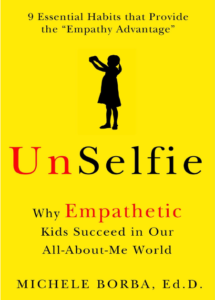Vanuatu, Tibet, Afghanistan, Denmark, and Armenia: How educators are activating students’ empathy and making a difference!
I’m convinced that empathy is the glue that holds a civilized society together, is the best antidote to stop bullying, aggression and intolerance, and empathy is slowing unraveling. I set out on a decade-long journey to find the best ways to cultivate empathy. I literally flew the world, spoke with countless of researchers, conducted focus groups with hundreds of children, and visited dozens of schools. I learned that empathy can be cultivated and the most effective ways were always meaningful, authentic ways that matched students’ needs.
Here are five of the most creative ways adults around the world are cultivating children’s empathy to create a world where their kids think WE, not ME, so they reap “The Empathy Advantage.” I included these ideas (and 300 more) in my latest book, UnSelfie: Why Empathetic Kids Succeed in Our All About Me World. The best news: these are simple ideas based on proven research that children love ,and they can be adapted or replicated anywhere!
Be Friendly
Empathy is always a “We” affair. A simple, overlooked way to increase empathy is by making the culture friendlier. Just being with people in a friendly setting can increase your empathy toward them and make you want to be kinder. The small South Pacific island of Vanuatu exemplifies that social premise. It’s called one of the“the Friendliest Place on Earth” and after visiting their island, I can see why. Everywhere residents greeted you with a sincere hello and a smile and seemed genuinely interested in you. Their friendliness was contagious, so you responded right back with a hello and a smile to a stranger.
When I asked Vanuatu residents why they were so friendly, their answer was simple: “Because everyone else is.”
Friendliness makes you tune in, observe emotional cues, be more receptive to others’ feelings and needs, and instead of walking by, you smile and acknowledge a person’s existence right back. And such traits are the gateway to empathy.
But you don’t have to move your family to the South Pacific to gain that “friendly effect.” Just intentionally take friendliness up a notch in your home, school, and neighborhood!
Activating empathy starts face-to-face or recognizing others. Saying a since “hello” may be the over looked answer to reclaiming conversation and rebuilding human connection. What are you doing to help your kids learn the “Friendly Factor”?
Break Down Barriers
Martin Hoffman, a leading empathy authority, points out that we are more likely to empathize with people in our immediate circles or care about those “like us.” Expanding our children’s familiarity circles to those “not like them” opens the path to empathy. Nowhere have I discovered the more creative way to break down barriers than in Kabul.
Skateistan was started in 2007 as an initiative to create educational and empowerment opportunities for Afghanistan’s youth and it uses skateboarding as a hook. Most participants are kids with the greatest social needs: working children, illiterate children, those from low-income families, and disabled youth and girls, who still face countless barriers. And 40 percent of Skateistan participants are girls—quite remarkable since women are banned from riding bicycles, associating with boys, or receiving an education. But 1,500 girls attend the skating school three days a week and skate in the afternoon through war-torn regions right alongside boys. Can you imagine? Boys are gaining a new perspective: “Girls are brave, confident and can skate “just like me”- and in some cases, even better!”
We must expose our children to diversity and expand their circles of familiarity at an earlier age. Empathy has limits: we care most about those who are like us, which increases the Empathy Gap.
Find opportunities to enlarge your child’s Circles of Caring so they are exposed and learn to appreciate “differences.” It’s one of the best ways to help kids learn to think We, not Me.
Give Kids a Voice
Today’s kids are growing up in a hyper-connected world, and admit they’d rather text than talk. But empathy is driven by face-to-face connection, and it’s why we must keep the art of conversation alive. A daily tradition at the ancient Sera Monastery in Tibet holds a key. Every afternoon monks gather in the courtyard built in 1419 to hold hour-long debates to grasp Buddhist philosophy. The session involves a “Defender” who sits and gives answers to the Challenger, who stands and asks questions. Each time they make a point, there are vigorous claps and dramatic hand slaps, and then pauses to consider their next argument carefully, all in a spirit of camaraderie and fun. No notes or books are allowed: debaters must depend on memorized points of doctrine and their understanding of the topic and ask nonstop questions.

I watched the debates with reporters from all over the world and though I didn’t understand a word, I knew I was observing a critical piece to cultivating empathy: “voice” practice. The monks created a daily ritual in which they practiced verbalizing their opinions face-to-face and hearing others’ ideas and feelings.
Empathy wanes without moral courage and moral identity. That’s why children must understand what they stand for and practice using their voices so they can speak out for others and we must help them learn courage and what they stand for. (Moral Courage is the eighth crucial Empathy Habit in UnSelfie; Moral Identity is the second. Both are teachable skills).
Those monks were practicing asserting themselves and describing their beliefs, and that’s exactly what our children need to do. In today’s digital-driven world, we must be more intentional about helping kids practice communicating face-to-face so conversation and empathizing aren’t lost.
How can you help your children practice listening to each other’s views and feelings? Do you have sacred unplugged digital times so they can connect up-cllose and personal?
Play Chess
The cognitive part of empathy is the ability to understand another’s thoughts and feelings—to step into their shoes.
One of the interesting perspective-taking lessons I observed was in Yerevan where elementary students were taught to play chess. Armenia is the first country in the world to make chess compulsory for each child over six years of age. Their rationale? To boost children’s character and leadership. I watched young Armenian students walk into their mandatory class, greet their chess teacher, sit face-to-face with their same-age opponent, and for the next hour engage in a one- on-one chess match. And they do so once a week.
The 1,500-year-old game is associated with increasing cognitive abilities, coping and problem-solving capacities, ocio-affective development, creativity, concentration, and improved reading and math scores, but as I recognized that chess is also powerful in cultivating perspective-taking. Students played face-to-face, imagined their opponent’s next plays, tuned in to emotional cues (“Does he look confident, hesitant, or anxious about that move?”), and predicted “if- then” scenarios (“If he moves that piece, then . . .”). Those students were learning to step into other’s shoes, but also having fun, building relationships, and practicing empathy-building skills.
In our Academic Rat Race to help our kids get those test scores, we might be overlooking simple ways to teach kids’ perspective taking like chess, board games, theater, role-playing, dress up or sandbox. Check your children’s agendas and ensure there are opportunities for human connection.
Build Caring Relationships
 Empathy opens when children are in places where they feel safe, accepted, and heard. And warm relationships are the incubator of caring—it’s why parents who have warm, close relationships with their children are more likely to raise empathetic kids. It’s also why classrooms and schools with positive climates have less bullying and students who feel less marginalized. We can and must work harder to create caring climates in our homes, schools, neighborhoods, and organizations.
Empathy opens when children are in places where they feel safe, accepted, and heard. And warm relationships are the incubator of caring—it’s why parents who have warm, close relationships with their children are more likely to raise empathetic kids. It’s also why classrooms and schools with positive climates have less bullying and students who feel less marginalized. We can and must work harder to create caring climates in our homes, schools, neighborhoods, and organizations.
Denmark, the land of the happiest people in the world takes empathy seriously, with an hour of empathy-building each week a required part the national curriculum for all kids aged 6 to 16. If someone is being left out, or bullied, or there is a disagreement that can’t be solved among a few students, in Klassens Tid, or class time, students talk through individual or group-level problems to try to find solutions together.
The goal is to create a safe and cozy atmosphere—the Danes call it hygee—where problems are aired and kids learn how to put things in perspective, and more importantly, talk and listen to one another. The practice has been around since the 1870s, but was codified in a 1993 education law and expanded since then. It’s also a way to create an inclusive learning community where students learn to recognize and care about one another. A caring culture is also the foundation of empathy.
 Cooperative Learning, Jigsaw Learning, Student Advisory, Clubs are other ways to build caring communities. What are you doing to help your students learn to listen and care about one another?
Cooperative Learning, Jigsaw Learning, Student Advisory, Clubs are other ways to build caring communities. What are you doing to help your students learn to listen and care about one another?
Empathy can be cultivated. Caring, creative educators in Vanuatu, Tibet, Afghanistan, Denmark, and Armenia are proving it.
What is the most creative way you’ve seen that activates children’s empathy?
* * * * *
Join me in starting national conversation about why our children need for empathy.
I’ll share proven ways in this blog that we can use to cultivate our children’s empathy and switch their attitudes from WE, not ME. The ideas and story from this post are adapted from my latest book, UnSelfie: Why Empathetic Kids Succeed in Our All About Me World which describes how to cultivate the Nine Crucial Habits of Empathy, and offers dozens of proven ways parents and teachers can use from toddlers to teens to do so.

